Plus Two Zoology Chapter 3 Principles of Inheritance and Variation Chapter Wise Question and Answers PDF Download: Students of Standard 12 can now download Plus Two Zoology Chapter 3 Principles of Inheritance and Variation chapter wise question and answers pdf from the links provided below in this article. Plus Two Zoology Chapter 3 Principles of Inheritance and Variation Question and Answer pdf will help the students prepare thoroughly for the upcoming Plus Two Zoology Chapter 3 Principles of Inheritance and Variation exams.
Plus Two Zoology Chapter 3 Principles of Inheritance and Variation Chapter Wise Question and Answers
Plus Two Zoology Chapter 3 Principles of Inheritance and Variation question and answers consists of questions asked in the previous exams along with the solutions for each question. To help them get a grasp of chapters, frequent practice is vital. Practising these questions and answers regularly will help the reading and writing skills of students. Moreover, they will get an idea on how to answer the questions during examinations. So, let them solve Plus Two Zoology Chapter 3 Principles of Inheritance and Variation chapter wise questions and answers to help them secure good marks in class tests and exams.
|
Board |
Kerala Board |
|
Study Materials |
Chapter wise Question and Answers |
|
For Year |
2021 |
|
Class |
12 |
|
Subject |
Zoology |
|
Chapters |
Zoology Chapter 3 Principles of Inheritance and Variation |
|
Format |
|
|
Provider |
How to check Plus Two Zoology Chapter 3 Principles of Inheritance and Variation Question and Answers?
- Visit our website - https://spandanamblog.com
- Click on the 'Plus Two Question and Answers'.
- Look for your 'Plus Two Zoology Chapter 3 Principles of Inheritance and Variation Question and Answers'.
- Now download or read the 'Class 12 Zoology Chapter 3 Principles of Inheritance and Variation Question and Answers'.
Plus Two Zoology Chapter 3 Principles of Inheritance and Variation Question and Answers PDF Download
We have provided below the question and answers of Plus Two Zoology Chapter 3 Principles of Inheritance and Variation Chapter wise study material which can be downloaded by you for free. These Plus Two Zoology Chapter 3 Principles of Inheritance and Variation Chapter Wise Question and answers will contain important questions and answers and have been designed based on the latest Plus Two Zoology Chapter 3 Principles of Inheritance and Variation, books and syllabus. You can click on the links below to download the Plus Two Zoology Chapter 3 Principles of Inheritance and Variation Chapter Wise Question and Answers PDF.
Question 1.
The 1:2:1 ratio with the pink flower in the F, – generation indicate the phenomenon of
(a) dominance
(b) codominance
(c) incomplete dominance
(d) segregation
Answer:
(c) incomplete dominance
Question 2.
Which of these is not a Mendelian disorder?
(a) Turner’s syndrome
(b) Sickle-cell anaemia
(c) Colourblindness
(d) Haemophilia
Answer:
(a) Turner’s syndrome
Question 3.
Crossing over is advantageous because it brings about
(a) variation
(b) linkage
(c) inbreeding
(d) stability
Answer:
(a) variation
Question 4.
Observe the relationship between first two words and suggest a suitable word to the fourth place.
- Genetic makeup: Genotype: External appearance: …………
- Multiple alleles: Blood GP: polygenic trait: ………..
Answer:
- Phenotype
- Skin colour is human/Kernel colour is wheat.
Question 5.
Law of segregation is also called law of
(a) probability
(b) purity of gametes
(c) independence of gametes
(d) Punnett hypothesis
Answer:
(b) purity of gametes
Question 6.
Complete it.
- 44+XXY: Klinifetter’s syndrome: 44+XO………….
- Monohybrid phenotypic ratio: 3:1, Dihybrid phenotypic ratio:………..
Answer:
- Turner’s syndrome
- 9:3:3:1
Question 7.
- 44A + Xo: Turner’s syndrome, 44A+XXY: …………
- Man: XX-XY: Birds:…………..
Answer:
- Klinefelter’s syndrome
- ZW-ZZ
Question 8.
Blood groups of father, mother, and their two children are given below. Work out the genotypes of each blood group.
- Father-AB group
- Mother-O group
- Daughter – A group
- Son B-group
Answer:
- Father – lA lB
- Mother – i i
- Son-lBi
- daughter lAi
Question 9.
Why do certain genes tend to be inherited together in a cell at the time of cell division?
Answer:
Due to linkage.
Question 10.
Pedegree analysis is used to study human genetics. Here individuals and their relationship are represented by symbols. Identify the following symbols.
Answer:
(a) Mating between relatives
(b) Female
Question 11.
Select the correctly matched pair/pairs from the following.
(A) Langdon Down-21st Trisomy
(B) Sutton and Bovery – Principle of inheritance
(C) Henking-X- body (X- chromosome)
(D) Morgan-Mutation
Answer:
A and C
Question 12.
Name the scientists who proposed chromosomal theory of inheritance?
Answer:
Sutton and Bovery
Question 13.
Select the correct statement or statements from the
following.
(A) Gain of additional chromosome is called aneuploidy.
(B) The affected individual of Turner’s and Klinfelter’s syndrome are fertile.
(C) Increase in the whole set of chromosome in an organism is called polyploidy.
(D) Expected F2 generation ratio of two genes which do not segregate independently is 9:3:3:1
Answer:
A and C are correct
Question 14.
Character of a genetic disorder is given below. ‘Presence of an additional X chromosome making chromosome number 47 (44 autosomes +XXY)’
- Identify the disorder
- Write another one character of this disease?
Answer:
- Klinfelters syndrome
- Gynacomastia
Plus Two Zoology Principles of Inheritance and Variation Two Mark Questions and Answers
Question 1.
Substitution of wrong amino acid valine instead of glutamic acid at the 6th position in glob in chain of Hb cause a disease in man.
- Name the disease.
- Draw the amino acid sequence HbA peptide and HbS peptide.
Answer:
- Sickle cell Anaemia
- HbA-
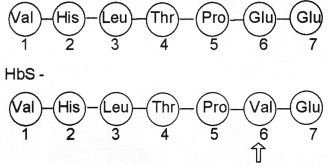
Question 2.
Prepare a table chart showing different human blood groups and its possible genotypes.
Answer: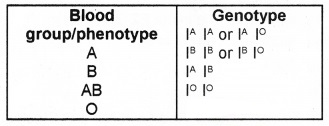
Question 3.
A man had the following symptoms.
A. short stature,
B. round head
C. puffy face
D. mouth always open with uncontrolled salivation, and
E. mental retardation.
Answer:
(a) Down’s syndrome
(b) It is caused by the trisomy of 21st pair of chromosome, so that there is a total of 47 chromosomes, instead of the normal 46.
Question 4.
Give one example for each of the following.
- Inborn error in metabolism.
- Sex-linked recessive disease.
- 21st trisomy.
- Autosome linked recessive disease.
Answer:
- Phenylketonuria
- Haemophilia
- Down’s syndrome
- Sickle-cell anaemia
Question 5.
Give reason. Phenylketonuria show accumulation of phenyl alanine in blood.
Answer:
In them, phenylalanine does not convert into tyrosine, due to the lack of enzyme due to gene mutation.
Question 6.
Observe the crossing of Mirabilis plant and the young ones given below.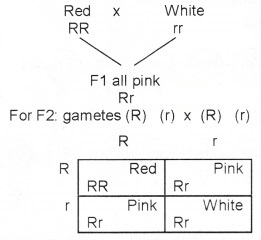
- Name the type of phenomenon of the above crossing?
- Write the ratio in the F2 Generation.
Answer:
- Incomplete dominance
- 1:2:1
Question 7.
In an experiment, Red flowered 4 O’clock plant is crossed with a White-flowered 4 O’clock plant. The F1 generation plant is crossed and produced the F2 generation. The phenotypic and genotypic ratio is 1:2:1. Name the type of inheritance? Explain.
Answer:
Incomplete dominance.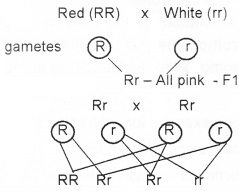
Phenotypic & genotypic ratio is 1:2:1.
Question 8.
The percentage of nucleotide Adenine in DNA isolated from human liver is observed to be 30.7%. What is the expected percentage of T, G and C. Justify?
Answer:
T = 30.7%
G = 19.3%
C = 19.3%
The amount of A always equals to T. So the percentage of T is expected to be very close to 30.7%. G and C together would make up the remainder or 100 – (30.7 + 30.7) = 38.6, thus the percentage of C and G separately would be expected to equal half of 38.6 or 19.3.
Question 9.
Identify the given symbols used in pedigree charts.
Answer:
- Sex unspecified
- Parents above and children below.
- Male
Question 10.
XXY chromosome pattern is the characteristic feature of a genetic disorder.
- Write the name of the genetic disorder.
- Write the phenotypic expressions of this disorder.
Answer:
- Klinefelter’s syndrome
- Tall stature with feminised characters like gynaecomastia etc. sterile.
Question 11.
Karyotype of human chromosome compliment is given below. It has some abnormality.
- Identify the abnormality.
- Mention any one consequence of this abnormality.
Answer:
- Trisomy in 21st Chromosome, having a total of 47 chromosomes instead of the normal 46 leading to Down’s syndrome.
- It leads to physical, psychomotor and mental retardation.
Question 12.
Copy the table and fill the gap appropriately.
Answer: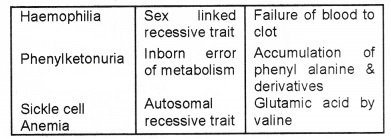
Question 13.
A man with blood group A married a woman with B group. They have a son with AB blood group and a daughter with blood group O. Workout the cross and show the possibility of such inheritance.
Answer:
Parents – Father – lA i – A group
Mother -1A i – B group
Son – lA lB – AB group
Daughter – i i – O group
Question 14.
Identify the type of cross made in flow chart. Explain its significance.
Answer:
Test cross
The progenies of test cross can easily be analysed to predict the genotype of the test organism.
Question 15.
If the frequency of a parental form is higher than 25% in a dihybrid test cross, what does that indicate about the two genes Involved?
Answer:
It indicates that linkage is being shown by two genes of parental forms and they are not exhibiting the phenomenon of independent assortment.
Question 16.
How is a child affected if it has grown from the zygote formed by an XX-egg fertilised by a Y-carrying sperm? What do you call this abnormality?
Answer:
The union of an abnormal XX egg and a normal Y- sperm results in trisomy of sex (X) chromosome. This is a type of sex chromosomal abnormality where the individual has 47 chromosomes (44 + XXY) and the abnormality is called Klinefilter’s syndrome.
Question 17.
Who proposed the chromosomal theory of inheritance? Point out any two similarities in the behaviour of chromosomes and genes.
Answer:
Sutton and Boveri
- Both factors/ genes and chromosomes occur in pairs in normal diploid cells.
- Both of them segregate/ separate during game to genesis and enter different gametes, i.e., one member of an allelic pair enters one gamete and the other enters another gamete.
Question 18.
If the frequency of a parental form is higher than 25% in a dihybrid test cross, what does that indicate about the two genes involved?
Answer:
It indicates that linkage is being shown by two genes of parental forms and they are not exhibiting the phenomenon of independent assortment.
Question 19.
In a seminar a student says ABO Blood group is an example for multiple alleles. Are you agree with this? Justify your answer.
Answer:
Yes. ABO blood groups are controlled by the gene I, which has three alleles, namely lA, lB, i, which produce six different combinations and six genotypes of the human ABO blood types.
Question 20.
Sickle cell anaemia is a genetic disorder. It is produced by gene mutation. Justify the statement.
Answer:
Sickle cell anaemia is caused by the substitution of glutamic acid by valine, which is due to the single base substitution at the sixth codon of the beta-globin gene from GAG to GUG.
Question 21.
Analyse the figure, find out the error and correct.
Answer: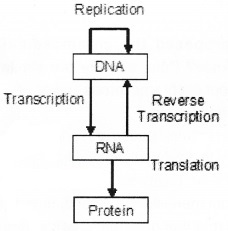
Question 22.
Fill in the vacant columns.
| Name of syndrome | Chromosome composition | Symptoms |
| a | b | Breast develop |
| c | 44AA+xO | d |
| Down syndrome | e |
Answer:
| Name of syndrome | Chromosome composition | Symptoms |
| Klinefelter’s syndrome | 44AA+XXY | Breast develop |
| Turners syndrome | 44AA+XO | Poor breast development |
| Down syndrome | 45A+XX/XY | Short stature Small round head retarded mental development |
Question 23.
In an experiment, Red flowered 4 O’clock plant is crossed with a White-flowered 4 O’clock plant. The F1 generation plant is crossed and produced the F2 generation. The phenotypic and genotypic ratio is 1:2:1. Name the type of inheritance? Explain.
Answer:
Incomplete dominance.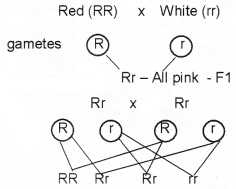
Phenotypic & genotypic ratio is 1:2:1.
Question 24.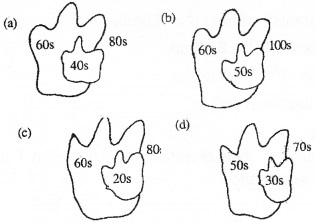
Find out the eukaryotic ribosome. Justify your answer.
Answer:
Eukaryotic ribosome is 80s ribosome, which is composed of a large sub unit 60s and a small subunits 40s.
Question 25.
A cluster of contrasting traits selected and studied by Mendel is given. Categories them into dominant and recessive traits.
Answer:
| Dominant | Recessive |
| Violet flower | White flower |
| Green pod | Yellow pod |
| Axial flower | Terminal flower |
| Round seeds | Wrinkled seeds |
Question 26.
In a hybridization experiment between tall pea plants and dwarf pea plants, a student observed 100% dominant parental traits in F1 generation and 75% dominant, 25% recessive parental traits are observed in F2 generation.
- Identify the type of cross
- Represent F2 generation using Punnet square.
Answer:
1. Monohybrid Cross
2.
| T | t | |
| T | TT -Tall | Tt- Tall |
| t | Tt- Tall | Tt- Dwarf |
Question 27.
‘Incomplete dominance is an exception to the principle of dominance’
- Do you agree with statement? Justify?
- Explain the principle of dominance.
Answer:
1. Yes, in incomplete dominance intermediate character appears and neither character is completely dominant over the other.
2. In law of dominance, in a heterozygous pair of factors one member of the pair dominates (dominant) the other (recessive).
Question 28.
What is test cross? Design a test cross of the following characters/traits of pea plant.
- Tall X Dwarf
- Violet flower X White
Answer:
Crossing of F1 progeny with recessive parent
- Tt × tt, Offsprings 50% Tt & 50% tt
- Ww × ww, offsprings 50% – Ww & 50% ww

Question 29.
The amino acid composition of a portion of beta polypeptide chain of haemoglobin is given.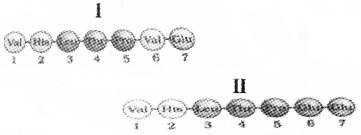
- Identify the beta chain of sickle cell anaemia patient?
- Write the difference between the Beta chain of normal haemoglobin and the Beta chain of sickle cell anaemia haemoglobin?
Answer:
- 1 chain
- Substitution of glutamic acid by valine at the sixth position of beta chain of Hbs peptide.
Question 30.
A representative figure of an individual affected with a chromosomal/genetic disorder is given.
- Identify the disorder?
- Write the genetic reason of this disease?
Answer:
- Down’s syndrome
- 21st trisomy/Non-disjunction of chromosomes during Anaphase I of meiosis.
Question 31.
Compare the chromosomal mechanism of sex determination of the following animals.
- Drosophila
- Grasshopper
Answer:
1. XX (female) and XY (male) – Male heterogamety – Male has two sex chromosomes X and Y. Half the sperms with X chromosome and the other Half with a Y chromosome.
2. XX (Female) and XO (male) – Male heterogamety – Male has one Sex chromosome, only X chromosome. Half the sperms with X chromosome and the other half without an X chromosome.
Question 32.
ABO blood group is considered as an example of multiple allelism and Codominance. Explain?
Answer:
ABO blood group is controlled by more than two alleles — lA, lB and i. A group lAlA, lA,i, B group—lBlB, lBi , AB group lA, lB, O group – ii
In AB blood group both lA and lB alleles behave as dominant genes, producing both A and B antigens.
Question 33.
In Snapdragon F1 progeny shows pink coloured flowers when a cross in made between red flowered and white flowered plants.
- What is the genetic reason of this phenomenon?
- Find out the phenotypic ratio of F2 generation of the same cross.
Answer:
- Incomplete dominance
- 1 (Red): 2 (Pink): 1 (White)
Question 34.
Categorize following diseases into sex-linked recessive disorder and autosome linked recessive disorders. Write the characters of each?
- Haemophilia
- Phenyl ketonuria
Answer:
- Sex-linked recessive, absence of blood clotting due to the lack of a protein.
- Autosome linked recessive, absence of enzymes that convert phenylalanine to tyrosine.
Question 35.
Differentiate between Homozygous and heterozygous condition with an example.
Answer:
Alleles of a gene are similar in homozygotes,
E.g. TT for tall, tt for dwarf
Alleles of a gene are dissimilar in heterozygote/ heterozygous.
E.g. Tt heterozygous tall.
Question 36.
Analyse the following statements.
(A) Deletions and insertions of base pair of DNA causes Frame shift mutation.
(B) Chemical and physical factors that induce mutation are referred as polyploidy.
Identify the wrong statement and rectify the mistake
Answer:
(B) is wrong
Chemical or physical factors that induce mutation are referred as mutagens and increase in the whole set of chromosome is called polyploidy.
Question 37.
Is it possible for:
- Awomanto inherit X chromosome from her father?
- A man to inherit X chromosome from his father?
Answer:
- Yes. Father give X to female and Y to male offspring
- No, Father give X to female and Y to male offspring.
Question 38.
Blood groups of father, mother, and their two children are given below. Work out the genotypes of each blood group.
- Father – AB group
- Mother – O group
- Daughter – A group
- Son B – group
Answer:
- Father- lA lB,
- Mother- i i,
- Son – lBi,
- daughter lA i
Question 39.
‘Down’s syndrome and Turner’s syndrome are examples of aneuploidy’. Substantiate.
Answer:
Loss or gain of chromosomes is called aneuploidy Down’s syndrome is 21st trisomy-total number of chromosomes is 47, gain of one chromosome In Turners syndrome one X chromosome is lost which results in 44 autosomes and one sex chromosomes.
Plus Two Zoology Principles of Inheritance and Variation Three Mark Questions and Answers
Question 1.
In one of his dihybrid crosses, Mendel crossed a true breeding double dominant pea plant with round and yellow seeds with true breeding double recessive plant having wrinkled and green seeds. The phenotypic ratio got was 9:3:3:1. Using checker board, try to find out the genotypic ratio.
Answer:
Phenotypic ratio –
- Round yellow – 9
- Round green – 3
- Wrinkled yellow – 3
- Wrinkled green -1
Phenotypic ratio – 9 3 3 1
Dihybrid genotypic ratio is 1:2:2:4:1:2:1:2:1
Question 2.
State whether the following statements are true or false. If false, rewrite them by changing the word underlined.
- A chromosome is mostly made up of RNA.
- Down’s syndrome is caused by the trisomy of the 10th chromosome.
- The somatic cells of females have XX pair of sex chromosome.
- In a normal dihybrid cross, phenotypic ratio is 9:3:3:1.
Answer:
- A chromosome is mostly made up of DNA.
- Down’s syndrome is caused by the trisomy of the 21st chromosome.
- The somatic cells of females have XX pair of sex chromosome-True.
- In a normal dihybrid cross, phenotypic ratio is 9:3:3:1 -True.
Question 3.
Chromosomal mechanism of sex determination involves different types of mechanisms. Three such types are given.
XO type
XY type
ZW type
- Give example for each type.
- Differentiate between male heterogamety and female heterogamety.
- Is the sperm or egg responsible for the sex of the chicks?
Answer:
1. XO type – Grasshopper
XY – Man, Drosophila
ZW – Birds
2. Sex determination mechanism in which males produce two different types of gametes (say X and Y) is called male heterogamety and if female produce two types of gametes (Say Z and W), it is called female heterogamety.
3. In chick, it is the egg which determines the sex. ZW is female and ZZ is male. Z and W are produced by the egg not sperms.
Question 4.
Human ABO blood groups are controlled by the gene l, which has three alleles lA, lB and i. Each person possesses any two of the three I gene alleles. Make a table showing the different combinations of these three alleles that are possible in human.
Answer:
Question 5.
Experimental verification of the chromosomal theory of inheritance on Drosophila melanogaster led to discovering the basis for variation that sexual reproduction produced.
- Name the scientist who formulated chromosome theory of inheritance.
- Who expanded it by experimental verification?
- Why did he select Drosophila melanogaster for his studies?
Answer:
1. Sutton and Bovery
2. Thomas Hunt Morgan
3. Drosophila was very suitable for his studies because
- They could be grown on simple synthetic medium.
- Complete life cycle in 2 weeks.
- A single mating could produce a large progeny.
- Male and female are easily distinguishable
- Many hereditary variations can be seen with low power microscope
Question 6.
According to common Mendelian pattern of inheritance, F1 resembles the dominant parent. But in contrast, there are certain other patterns of inheritance in which F1 does not resembles either of the parents.
- Name the pattern of inheritance in which F1 shows a character in between the two parents.
- Citing an example write the phenotypic ratio of F2 in the above cross.
- Name the pattern of inheritance in which F1 resembles both parents.
Answer:
1. Incomplete dominance
2. Eg: Flower colour in Snapdragon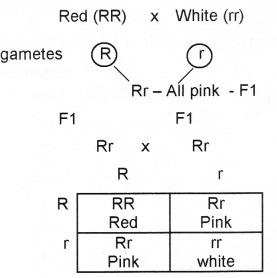
Phenotypic ratio -1:2:1
3. Co-dominance.
Question 7.
- What is Pedigree analysis?
- Write any two Mendelian disorders in man.
- Give an example each for Autosomal recessive and autosomal dominant traits.
Answer:
1. Analysis of traits in several generations of a family is called pedigree analysis. It helps to study the family history about inheritance.
2. two Mendelian disorders in man:
- Haemophilia
- Sickle-cell Anemia
- Cystic fibrosis
- Colourblindness
3. Autosomal recessive trait – Sickle cell anemia Autosomal dominant trait – Muscular dystrophy
Question 8.
In one of his dihybrid crosses, Mendel crossed a true breeding double dominant pea plant with round and yellow seeds with true-breeding double recessive plant having wrinkled and green seeds. The phenotypic ratio got was 9:3:3:1. Using a checkerboard, try to find out the genotypic ratio.
Answer: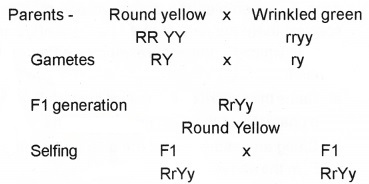
- Round yellow – 9
- Round green – 3
- Wrinkled yellow – 3
- Wrinkled green -1
Phenotypic ratio – 9 3 3 1
Dihybrid genotypic ratio is 1:2:2:4:1:2:1:2:1
Question 9.
What do you understand by the following symbols of Pedigree analysis?
Answer:
(A) Mating
(B) Mating between relatives
(C) Parents above and children (Two) below, one son and one daughter.
Question 10.
‘In human being father is responsible for the sex of child’. Based on |he knowledge of chromosomal mechanism of sex determination, substantiate this statement?
Answer:
During spermatogenesis, two types of gametes are produced of which 50 percent carry the X- chromosome and the rest 50 percent has Y-chromosome besides the autosomes.
Females produce only one type of ovum with an X- chromosome. In case the ovum fertilises with a sperm carrying X- chromosome the zygote develops into a female (XX) and with Y-chromosome results into a male offspring. Thus the genetic makeup of the sperm that determines the sex of the child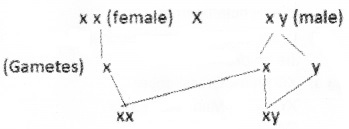
Question 11.
Observe the following pedigree chart
- What is the indication of symbols □ and ○
- Some symbols are shaded or darkened why?
- Write the significance of pedigree chart?
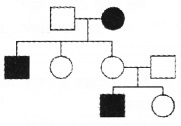
Answer:
1. ○ – Female, □ – Male
2. Affected individuals
3. Pedigree charts are important for examining genetics in family. It can be used to track certain traits in family members through two or more generations of a family.
Question 12.
In a pea plant the gene for yellow seed colour (YY) is dominant to green (yy) and round seed (RR) is dominant to wrinkled (rr). With the help of Punnet square, find out the offspring of F2 generation of the following cross. Yellow Round seeds x Green wrinkled seeds (Homozygous for both characters)
Answer: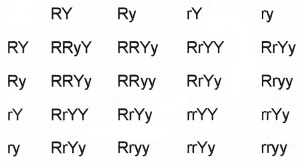
Phenotypic ratio: 9 : 3 : 3 : 1.
Question 13.
Match columns A with column B.
| A | B |
| a. Operon concept | Semiconservative method |
| b. DNA finger printing | Erythroblastosis foetalis |
| c. Lathyrus Odaratus | Criss-cross inheritance |
| d. Rh factor | Lactose-metabolism |
| e. Haemophilia | Southern Blotting |
| f. DNA Replication | Linkage |
Answer:
| A | B |
| a. Operon concept | Lactose-metabolism |
| b. DNA finger printing | Southern Blotting |
| c. Lathyrus Odaratus | Linkage |
| d. Rh factor | Erythroblastosis foetalis |
| e. Haemophilia | Criss-cross inheritance |
| f. DNA Replication | Semiconservative method |
Question 14.
Compare incomplete dominance and codominance with suitable examples?
Answer:
| Incomplete dominance | Co dominance |
| Eg: – Flower color in 4 ‘0’ clock Plant | AB blood group in man |
| Both dominant and recessive characters are present | Only dominant characters are seen |
| Dominant character fails to suppress recessive character & Presence of intermediate character | No such suppression. Both dominant characters appear at time. |
Plus Two Zoology Principles of Inheritance and Variation NCERT Questions and Answers
Question 1.
Briefly mention the contribution of T.H. Morgan in genetics.
Answer:
Thomas Hunt Morgan put forth chromosome theory of linkage from his work on fruit fly (Drosophila melanogaster). He established the principle of linkage, discovered sex linkage and technique of chromosomal mapping. He wrote a book Theory of gene’ and was awarded Nobel Prize in 1933.
Question 2.
What is pedigree analysis? Suggest how much an analysist can be useful?
Answer:
A record of inheritance of certain traits for two or more generations presented in the form of a diagram or family tree is called pedigree. Analysis of traits in a several generation of a family is called as pedigree analysis. It is employed in case of human beings and domesticated animals.
Importance:
In human genetics, pedigree study provides a strong tool which is utilized to trace the inheritance of a specific trait, abnormality or disease.
It is useful for the genetic counselors to advice in tending couples about the possibility of having children with genetic defects like hemophilia, colour blindness, alkaptonuria, thalassemia, and sickle all anemia.
Question 3.
How is sex determined in human beings?
Answer:
If the zygote is having XX chromosomes in last pair, then it will be female child. If zygote is having XY chromosome then it will be a male child.
Question 4.
A child has blood group O. If the father has blood group A and mother blood group B, work out the genotypes of the parents and the possible genotypes of the other offsprings.
Answer:
The parents of the child will be heterozygous for their blood groups. Therefore, his father with blood group A must-have genotype (lA lo) and mother with blood group B must have genotype (lB lo).
Question 5.
Explain the following terms with examples:
- Co-dominance
- Incomplete dominance
Answer:
1. The alleles which are able to express themselves independently when present together are called co-dominant alleles and this phenomenon is called codominance e.g. AB blood group inheritance in humans.
2. In this phenomenon of the contrasting characters are dominant. The expression of the trait in F1 hybrid is intermediate e.g. pink flowers in peaplant.
Mention the advantages of selecting pea plant for experiment by Mendel. Pea is a annual plant which gives result within a year.
Large number of are produced by pea plant in one generation. Pea plant has short life cy large number of true breeding varities with observable alternative forms trait were available.
Plus Two Zoology Principles of Inheritance and Variation Multiple Choice Questions and Answers
Question 1.
Mating of an organism to a double recessive in order to determine whether it is homozygous or heterozygous for a character under consideration is called
(a) reciprocal cross
(b) test cross
(c) dihybrid cross
(d) back cross
Answer:
(b) test cross
Question 2.
A dihybrid for the traits is crossed with homozygous recessive individual of its type, the phenotypic ratio is
(a) 1 : 2: 1
(b) 3
(c) 1 : 1:1:1
(d) 9:3:3:l
Answer:
(c) 1 : 1:1:1
Question 3.
A dihybrid test cross yielding a result of 1:1:1 ratio is indicative of
(a) four different types of gametes produced by the F1 hybrid
(b) homozygous condition of the F1 -dihybrid
(c) four different types of F1 -generation dihybrids
(d) tour different types of gametes produced by the-parent
Answer:
(a) four different types of gametes produced by the F1 hybrid
Question 4.
When a dihybrid cross is fit into a Punnett square with 16 boxes, the maximum number of different phenotypes available are
(a) 8
(b) 4
(c) 2
(d) 16
Answer:
(b) 4
Question 5.
Cross between unrelated group of organisms is called
(a) hybrid
(b) test cross
(c) hack cross
(d) heterosis
Answer:
(a) hybrid
Question 6.
A pure tall and a pure dwarf plant were crossed to produced offsprings. Offsprings were self crossed, then find out the ratio between true breeding tall to true breeding dwarf?
(a) 1: 1
(b) 3:1
(c) 2:1
(d) 1:2:1
Answer:
(a) 1:1
Question 7.
Genotypic ratio of a monohybrid cross is
(a) 1:2:1
(b) 3:1
(b) 9:3:3:1
(d) !:1:1
Answer:
(a) 1:2:1
Question 8.
Ratio of progeny, when a red coloured heterozygote is crossed with a white coloured plant in which red colour is dominant to white colour
(a) 3:1
(b) 1:1
(c) 1:2:1
(d) 9:3:3:1
Answer:
(b) 1:1
Question 9.
Leaf colour in Mirabilis jalapa is an example of
(a) non-Mendelian inheritance
(b) Mendelian inheritance
(c) chemical inheritance
(d) Both (b) and (c)
Answer:
(a) non-Mendelian inheritance
Question 10.
The F2-generation offspring in a plant showing incomplete dominance, exhibit
(a) variable genotypic and phenotypic ratio
(b) a genotypic ratio of 1:1
(c) a phenotypic ratio of 3: 1
(d) similar phenotypic and genotypic ratio of 1:2:1
Answer:
(d) similar phenotypic and genotypic ratio of 1:2:1
Question 11.
The total number of progeny obtained from a dihybrid cross is 1280 in F2 -generation. How many of them are recombinant type?
(a) 240
(b) 360
(c) 400
(d) 720
Answer:
(c) 400
Question 12.
A test cross is performed
(a) by selfing of F7-generation plants
(b) by selfing of F1 -generation plants
(c) to determine whether F1 -plant is homoygous or heterozygous
(d) between a homozygous dominant and homozygous recessive plant
Answer:
(c) to determine whether F1 -plant is homoygous or heterozygous
Question 13.
Crossing over is advantageous because it brings about
(a) variation
(b) linkage
(c) inbreeding
(d) stability
Answer:
(a) variation
Question 14.
If a plant having yellow or round seeds was crossed with another plant having green and wrinkled seeds then F1 -progeny are in the ratio
(a) 15: 1
(b) 1 15
(c) 1: 13
(d) All yellow and round seeds
Answer:
(d) All yellow and round seeds
Question 15.
When a diploid female plant is crossed with a tetraploid male, the ploidy of endosperm cells in the resulting seed
(a) tetraploidy
(b) pentaploidy
(c) diploidy
(d) triploidy
Answer:
(a) tetraploidy
Question 16.
In certain plant species, red flower colour is incompletely dominant to white flower colour (the heterozygote is pink) and tall stems are completely dominantto dwarf stern. If a tall pink plant (TtRr) is crossed with a tall white plant (TTrr). which one of the following type of plants would be produced in the offsprings
(a) Tall pink and tall white
(b) Dwarf pink and tall red
(c) Dwarf red and tall pink
(d) Tall pink and dwarf white
Answer:
(d) Tall pink and dwarf white
Question 17.
The important events of segregation takes place during
(a) prophase I
(b) anaphase I
(c) prophase II
(d) anaphase II
Answer:
(b) anaphase I
Question 18.
The phenotypic ratio obtained by Mendel in dihybrid cross is
(a) 3:3:1:1
(b) 1:2:1
(c) 9:3:31
(d) 3:1
Answer:
(c) 9:3:31
Question 19.
The unknown genotype of individual is determined by
(a) dihybrid cross
(b) back cross
(c) test cross
(d) monohybrid cross
Answer:
(c) test cross
Question 20.
The studies of incomplete dominance is conducted on
(a) pisum
(b) snapdragon
(c) lathyrus
(d) fruit flies
Answer:
(b) snapdragon
Question 21.
Codominance is shown by the alleles of
(a) lAi
(b) lB i
(c) lAlB
(d) ii
Answer:
(c) lAlB
Question 22.
The experimental proof for the theory of inheritance was provided by the studies on
(a) pisum
(b) oenothera
(c) lathyrus
(d) fruit flies
Answer:
(d) fruit flies
Question 23.
Gynaecomastia is the case arises by
(a) increase in the number of sex chromosomes
(b) increase in the number of autosomes
(c) increase in the number of autosomes and sex chromosomes
(d) none of the above
Answer:
(a) increase in the number of sex chromosomes
Question 24.
2n-1 is an example of
(a) polyploidy
(b) aneuploidy
(c) euploidy
(d) diploidy
Answer:
(b) aneuploidy
Question 25.
The disease transmitted from father to grandson through daughter in zig-zag manner is an example of
(a) sickle cell anemia
(b) hemophilia
(c) phenyl ketonuria
(d) Turners syndrome
Answer:
(b) hemophilia
Question 26.
Monosomy is represented by the condition of
(a) 2n+1
(b) 2n-1
(c) 2n-2
(d) n-1
Answer:
(b) 2n-1
Plus Two Zoology Principles of Inheritance and Variation SCERT Sample Questions and Answers
Question 1.
A. Carefully read the following symptoms and identify genetic disorders.
- Autosomal linked recessive trait where RBC become sickle-shaped.
- Inborn error of metabolism, where phenylalanine accumulates in the blood.
- Disorderdueto absence of ‘X’ chromosome. (3)
Answer:
- Sickle cell anaemia
- Phenyl Ketonuria
- Turners’ Syndrome
OR
B. Write the contribution of the following biologists in connection with genetics.
- Henking
- T.H. Morgan
- Sutton and Boveri (3)
Answer:
1- Henking- He gave the importance of X body transfer in spermatogenesis of insects
2 – T.H. Morgan – Morgan gave the importance of physical association or linkage of the two genes and coined the term linkage.
3 – Sutton & Boveri – He gave the importance of the pairing and separation of a pair of chromosomes would lead to the segregation of a pair of factors they carried, it is called chromosomal theory of inheritance.
Question 2.
Write the gametes produced from self crossing of genotype RrYy. (2)
Answer:
RY, Ry, rY, ry
Plus Two Zoology All Chapters Question and Answers
- Plus Two Zoology Chapter Wise Question and Answers PDF
- Plus Two Zoology Chapter 1 Human Reproduction Chapter Wise Question and Answers PDF
- Plus Two Zoology Chapter 2 Reproductive Health Chapter Wise Question and Answers PDF
- Plus Two Zoology Chapter 3 Principles of Inheritance and Variation Chapter Wise Question and Answers PDF
- Plus Two Zoology Chapter 4 Molecular Basis of Inheritance Chapter Wise Question and Answers PDF
- Plus Two Zoology Chapter 5 Evolution Chapter Wise Question and Answers PDF
- Plus Two Zoology Chapter 6 Human Health and Disease Chapter Wise Question and Answers PDF
- Plus Two Zoology Chapter 7 Microbes in Human Welfare Chapter Wise Question and Answers PDF
- Plus Two Zoology Chapter 8 Biodiversity and Conservation Chapter Wise Question and Answers PDF
Benefits of the Plus Two Zoology Chapter 3 Principles of Inheritance and Variation Chapter Wise Question and Answers PDF
The Plus Two Zoology Chapter 3 Principles of Inheritance and Variation Chapter Wise Question and Answers PDF that has been provided above is extremely helpful for all students because of the way it has been drafted. It is designed by teachers who have over 10 years of experience in the field of education. These teachers use the help of all the past years’ question papers to create the perfect Plus Two Zoology Chapter 3 Principles of Inheritance and Variation Chapter Wise Question and Answers PDF.
0 comments:
Post a Comment